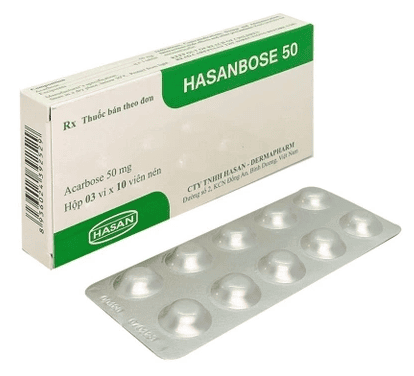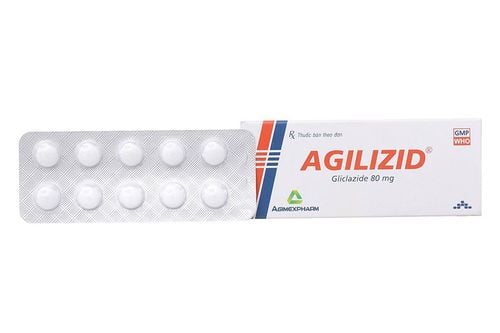This is an automatically translated article.
Usarbose drug whose main ingredient is Acarbose, is used in the treatment of type 2 diabetes (non-insulin dependent). The following article will share detailed information about Usarbose drug.
1. What is Usarbose?
Usarbose drug belongs to the group of hormones, hormones and is made in the form of tablets packed in boxes of 3 blisters, 5 blisters, 10 blisters x 10 tablets.
Usarbose drug has 2 forms, Usarbose 50 with the main ingredient Acarbose 50mg and Usarbose 100 with the main ingredient Acarbose 100mg.
2. Indications for use of Usarbose
Usarbose is used in the following cases:
Using Usarbose as monotherapy: As an adjunct to diet and exercise to treat type 2 diabetes (non-insulin dependent) in patients with hyperglycemia Blood glucose, especially after eating, cannot be controlled by exercise and eating alone. Use of Usarbose in combination with a sulfonylurea as an adjunct to diet and exercise for the treatment of type 2 diabetes in patients with hyperglycemia not controlled by sulfonylurea or acarbose alone.
3. Dosage - How to take Usarbose
Use Usarbose at the beginning of a meal to lower blood glucose levels after eating. Usarbose dose must be adjusted by the doctor or pharmacist to suit each case, because the effectiveness and tolerability of Usarbose varies from patient to patient. Usarbose tablets must be chewed with the first meal or swallowed whole with some water just before eating.
During initial Usarbose treatment and dose adjustment Usarbose should be measured glucose one hour after eating to determine the response to treatment and the minimum effective dose of Acarbose. Thereafter, monitor hemoglobin glycosylate, approximately every 3 months to assess long-term blood glucose control.
3.1. Usarbose dosage Usarbose drug is used for adults including the elderly, always use the drug as prescribed by the doctor, the dose of Usarbose is adjusted by the doctor depending on the tolerability and response in each patient, the dose Usarbose reference as follows:
Initial dose: take 1 tablet of Usarbose / time, once or twice / day, then increase the dose of Usarbose to three times / day. If you experience unpleasant complications due to strict adherence to the diet, the dose of Usarbose should not be increased. The maximum dose is 200 mg Acarbose / time x 3 times / day. Usarbose drug is not used for children and adolescents, patients with renal failure with serum creatinine > 2 mg/dl. 3.2. What to do in case of an overdose of Usarbose? An overdose of Usarbose Acarbose can lead to bloating, flatulence and diarrhea. At this point, the patient needs to contact the doctor for advice on how to treat it appropriately.
4. Contraindications to the use of Usarbose
Usarbose drug is not used in the following cases:
Patients with hypersensitivity, allergy to Acarbose or other ingredients of the drug. Inflammation + intestinal ulcer. People who are prone to pathologies due to increased intra-abdominal pressure such as drug hernias have the potential to create gas in the intestines. Liver failure, increased liver enzymes. Lower blood sugar. Diabetic ketoacidosis. Pregnant and breastfeeding.
5. Usarbose drug interactions
Here are some Usarbose drug interactions that have been reported such as:
Patients when using foods containing sugar, eat sucrose (cane sugar) often will create an upset stomach or diarrhea, because Carbohydrates will increase fermentation in the colon. Acarbose in combination with iron may interfere with iron absorption or metabolism. Co-administration of sulfonylurea or biguanide antidiabetic agents with acarbose may be additive for blood glucose control, because of their different mechanisms of action. Usarbose should not be used in combination with antacids, intestinal adsorbents and digestive enzymes, cholestyramine because it may reduce the effect of acarbose. To ensure safety and avoid drug interactions, when taking Usarbose, the patient should inform the doctor or pharmacist about the drugs being used.
6. Side effects when taking the drug Usarbose
During the use of Usarbose, patients may experience some side effects such as:
Common
Digestive: Abdominal distension and pain, abdominal bloating, broken stools, diarrhea, nausea & vomiting. Uncommon
Liver: Abnormal liver function test. Skin: Itching, rash. Rare
Liver: Jaundice, hepatitis. Gastrointestinal side effects may be reduced with continued Usarbose treatment and simply reduced sugar intake. To minimize gastrointestinal side effects, patients should start treatment with Usarbose at the lowest dose and increase it gradually until desired results are achieved.
In the case of gastrointestinal side effects do not use antacids for treatment. Patients need to inform their doctor or pharmacist about the unwanted effects encountered when using Usarbose.
7. Precautions when using Usarbose
There have been reports of cases of increased liver enzymes, so it is necessary to monitor liver transaminases during treatment with Usarbose.
Hypoglycemia may occur when Usarbose is used concomitantly with a sulfonylurea antidiabetic agent or insulin. When treating hypoglycemia, oral glucose (dextrose) must be administered without sucrose because glucose absorption is not inhibited by acarbose.
Usarbose drug has no effect when used alone in diabetics with ketosis or coma, complications of acidosis. In this case, insulin should be used.
Do not use Usarbose for pregnant and lactating women.
Usarbose does not affect the ability to drive and use machines.
Note: Usarbose is prescribed by a doctor, the patient does not self-medicate. In addition to the above information, if you have any problems during use, you can contact the prescribing doctor directly for answers.













